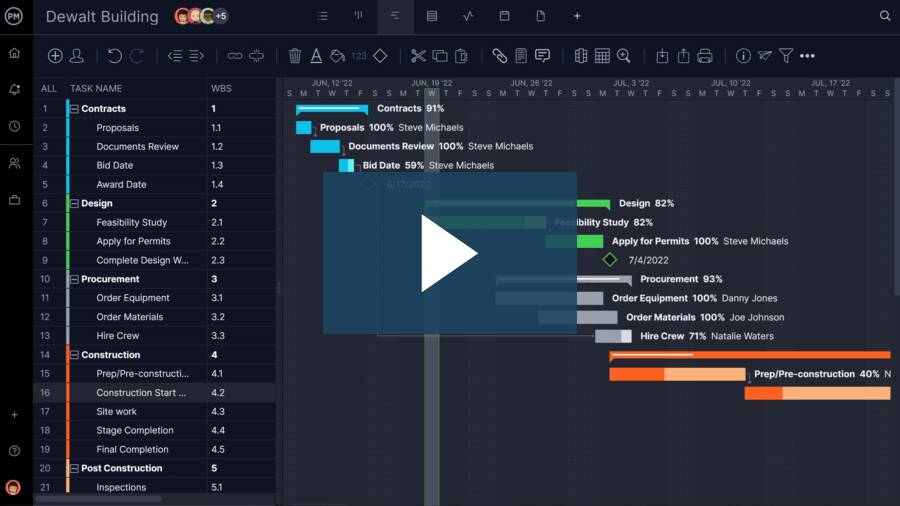Running a successful construction project takes many moving parts working together. From scheduling crews and managing budgets to coordinating with stakeholders and ensuring quality standards, leadership plays a central role in keeping everything on track. Two of the most important roles on a job site are construction managers and project managers, each bringing a different focus and skill set to the table.
Understanding how these roles differ helps owners, contractors, and teams set the right expectations and build stronger collaboration. Knowing where responsibilities overlap and where they diverge can prevent confusion, improve communication, and keep projects moving forward. By comparing a construction manager vs. a project manager side by side, you can see how they work together to deliver a project on time and within budget.
What Is a Construction Manager (CM)?
A construction manager oversees every stage of a construction project, from pre-construction planning to final delivery. They coordinate crews, manage subcontractors, track budgets, and make sure work is performed safely and to specification. They also handle procurement, site logistics, and quality control, working closely with architects, engineers, and inspectors to resolve issues as they arise. Their job requires balancing timelines, costs, and resources while keeping stakeholders informed and satisfied.
Construction managers spend a lot of time problem-solving on the job site, making real-time decisions to keep the schedule on track. They must anticipate delays, manage risk, and maintain strong communication between all parties involved. Their success is measured by whether the project is completed on time, within budget, and at the expected quality level, which makes having accurate, up-to-date information critical.
Project management software gives construction managers the tools they need to plan, monitor and adjust work as conditions change. With scheduling features, they can map out tasks, assign crews and track progress in real time. Budget tracking tools allow them to compare planned costs against actuals, while reporting features make it easy to share updates with owners and stakeholders. Collaboration tools ensure everyone stays connected, reducing miscommunication and rework.
ProjectManager brings all of these capabilities into one platform with multiple project views, including Gantt charts, kanban boards and task lists, so construction managers can work the way they prefer. Its real-time dashboards track labor, costs and progress so issues can be addressed quickly before they escalate. Resource management and workload tracking ensure crews are used efficiently, while secure file sharing and commenting keep communication organized. Our software makes it easier for construction managers to stay in control of complex projects and deliver results on schedule. Get started with ProjectManager today for free.
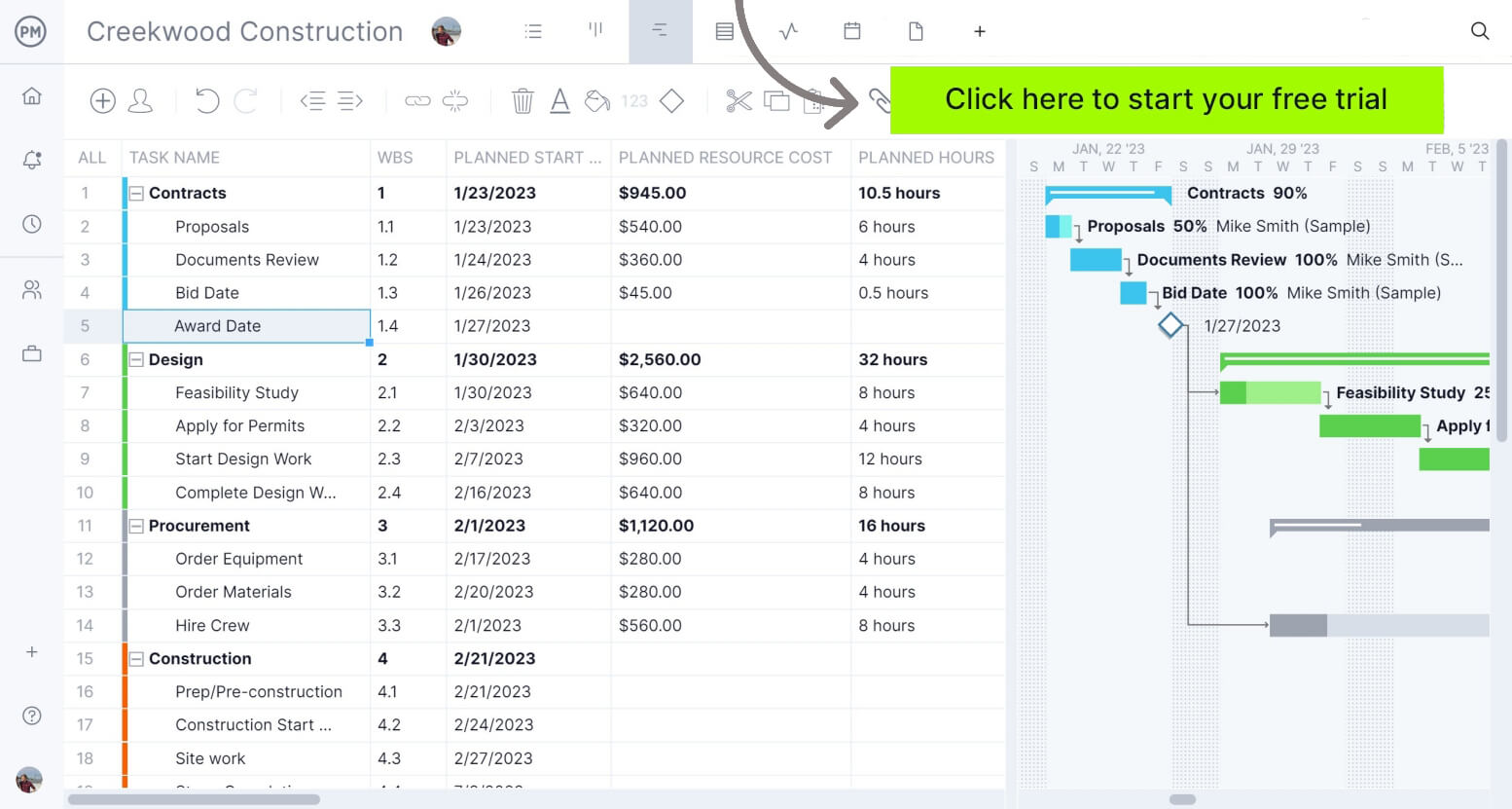
What Does a Construction Manager Do?
A construction manager oversees the entire building process from planning to completion. They coordinate people and resources to keep work moving efficiently and make sure the project stays on schedule and within budget. Their role is to manage day-to-day operations, solve problems quickly and ensure the finished project meets quality and safety standards.
Key Construction Manager Responsibilities
A construction manager leads the on-site delivery of a building project, turning plans into reality while balancing time, cost and quality. Below are the core responsibilities that define the role, each explained so you can see how they contribute to successful construction delivery.
- Project planning — Develops the overall construction plan, sequences tasks logically, coordinates with designers and owners, and sets milestones that guide the team from groundbreaking to handover.
- Scheduling — Creates and manages the project schedule, assigns timelines to crews and subcontractors, monitors progress daily, and adjusts sequences when delays or changes occur.
- Budgeting and cost control — Prepares cost estimates, tracks actual spending against the budget, approves invoices, and implements cost-saving measures to keep the project financially healthy.
- Resource allocation and workforce management — Assigns labor and equipment where they are needed most, balances workloads to avoid bottlenecks and ensures crews have the tools and training to perform safely and efficiently.
- Subcontractor coordination — Selects and manages subcontractors, defines scopes of work, enforces schedules and quality standards and resolves disputes that could impact delivery.
- Safety and compliance — Implements safety programs, enforces site rules, conducts inspections and ensures work meets regulatory and code requirements to protect workers and avoid costly violations.
- Quality assurance and control — Sets quality expectations, monitors workmanship through inspections and testing and ensures the finished product meets design specifications and owner expectations.
- Risk identification and mitigation — Identifies potential schedule cost and safety risks early, develops mitigation plans and responds quickly when issues arise to reduce impact on the project.
- Communication and stakeholder management — Keeps owners, subcontractors, inspectors and the project team informed through regular updates, meetings and reports so decisions are aligned and misunderstandings are minimized.
- Procurement and materials logistics — Manages ordering, delivery and storage of materials, coordinates with suppliers to prevent shortages and schedules deliveries to match site needs and avoid delays.

Get your free
Construction Schedule Template
Use this free Construction Schedule Template to manage your projects better.
Get the Template
What Is a Project Manager (PM)?
A project manager is responsible for planning, executing and closing projects across a wide range of industries. They oversee the entire project lifecycle, define goals, create schedules, manage resources, and keep teams aligned to ensure work is completed on time and within budget. Project managers work closely with stakeholders to clarify expectations, address risks, and resolve issues that could disrupt progress.
Their role is about coordination and communication as much as planning. A project manager brings together people from different departments, keeps everyone focused on priorities and tracks progress against milestones. They also monitor budgets and performance so problems are spotted early and corrective action can be taken before they impact project success.
What Does a Project Manager Do?
A project manager oversees the planning and delivery of projects from start to finish. They organize tasks, manage resources and keep the team aligned so work stays on schedule and within budget. Their job is to guide the project through each phase, solve problems as they come up, and make sure goals are met.
Key Responsibilities of a Project Manager
A project manager ensures a project moves from idea to delivery by coordinating people, processes and priorities. They provide direction and structure so teams know what to do, when to do it and why it matters. The following responsibilities outline the core areas where a project manager adds value across industries.
- Project initiation — Defines project objectives, secures stakeholder approval and establishes the project charter that sets scope, timelines and success criteria.
- Scope management — Clarifies what is in scope and what is out of scope, documents requirements and controls changes so the project delivers agreed outcomes.
- Schedule planning — Develops a realistic schedule, sequences tasks, sets milestones and monitors progress to keep the project on track.
- Budgeting and cost control — Estimates costs, tracks spending against the budget and implements corrective actions to prevent overruns.
- Resource management — Assigns people and equipment, balances workloads and ensures the team has what it needs to complete tasks efficiently.
- Risk management — Identifies potential problems, assesses their impact and likelihood and creates mitigation plans to reduce surprises.
- Stakeholder communication — Keeps stakeholders informed, manages expectations and facilitates decision making through regular updates and clear reporting.
- Quality management — Defines quality standards, monitors deliverables and ensures work meets requirements before it’s accepted.
- Procurement and vendor management — Oversees purchasing contracts, manages vendor performance and coordinates deliveries to support project timelines.
- Monitoring, reporting and closure — Tracks performance against the plan, produces status reports and leads project closeout activities to capture lessons learned and confirm acceptance.
Construction Manager vs. Project Manager: 8 Key Differences
Construction projects succeed when everyone knows their role and responsibilities. Comparing a construction manager vs. a project manager highlights where their duties overlap and where they differ. This breakdown of eight key differences illustrates how each position contributes to project success, helping owners and teams understand their respective roles and responsibilities on the job site.
1. Scope of Responsibility
Scope of responsibility refers to the range of duties each role covers from start to finish. It includes decision-making, authority oversight of people and processes and the level of involvement in planning, execution and delivery. A clear understanding of scope prevents duplication of work and ensures accountability throughout the project lifecycle.
Construction Manager
The construction manager’s scope focuses on overseeing all on-site activities. They manage subcontractors, coordinate schedules and ensure compliance with safety standards and building codes. Their job is to ensure daily operations run smoothly, solve problems quickly, and maintain productivity. Construction managers work closely with crews to make sure work meets quality expectations and is completed on time.
Project Manager
The project manager’s scope covers the entire project lifecycle from initiation through closing. They handle planning, budgeting, risk management and communication with stakeholders. Project managers track progress across multiple teams, ensuring that work aligns with project goals and client expectations. Their responsibility is broader and more strategic, balancing resources, timelines and deliverables to meet overall success criteria.
2. Timeline Involvement
Timeline involvement refers to how each role contributes to scheduling and meeting deadlines. It includes creating schedules, monitoring progress and making adjustments when delays occur. Both construction managers and project managers work to keep the project on time, but they engage with the schedule at different levels of detail and decision-making.

Construction Manager
The construction manager is hands-on with day-to-day scheduling. They coordinate subcontractors, adjust work sequences and respond to issues that could slow down progress. Their focus is tactical, making sure crews stay productive and tasks are completed as planned. They often communicate changes to the project manager to update the overall schedule.
Project Manager
The project manager develops the master schedule and oversees progress across all phases. They look at long-term deadlines, milestones and dependencies to ensure the project stays aligned with client goals. Their involvement is strategic, balancing timelines between multiple teams and making decisions that keep the project on track at a higher level.
Related: 20 Free Excel Construction Templates
3. Primary Focus
Primary focus describes what each role prioritizes in their day-to-day work. It defines whether their attention is on operations strategy or overall project direction. Understanding primary focus helps teams know where to go for decisions and who is responsible for specific aspects of project success.
Construction Manager
The construction manager’s primary focus is execution. They spend most of their time on-site managing workers, ensuring safety and troubleshooting problems. Their goal is to keep work moving smoothly without sacrificing quality. They are deeply involved in coordinating materials and labor to meet daily targets and respond quickly to operational challenges.
Project Manager
The project manager’s primary focus is planning and oversight. They concentrate on project objectives, budgets, risks and stakeholder expectations. Their role is to maintain alignment between the client’s vision and the team’s execution. They look at the big picture, making sure decisions support the overall project goals and deliver the expected results.
4. Decision-Making Authority
Decision-making authority refers to the level of control each role has over project outcomes. It covers who approves changes, makes resource allocations and resolves conflicts. Understanding this difference ensures clear communication and prevents delays caused by unclear ownership of key decisions.
Construction Manager
The construction manager makes operational decisions related to daily work on-site. They decide how to sequence tasks, assign crews and handle immediate challenges. While they have authority over site activities, they typically escalate significant scope or budget changes to the project manager for approval before proceeding.
Project Manager
The project manager has broader decision-making authority that spans the entire project. They approve scope changes, adjust budgets and manage risks that affect delivery. Their decisions are guided by stakeholder expectations and project goals, balancing constraints to keep the project on track while minimizing negative impacts on cost and schedule.
5. Interaction with Stakeholders
Interaction with stakeholders refers to how each role communicates with clients, vendors and other project participants. It includes the frequency, type and purpose of communication and determines how information flows between the field and project leadership.

Construction Manager
The construction manager mainly interacts with subcontractors, inspectors and on-site personnel. They focus on operational communication such as progress updates, site safety and addressing issues in real time. They serve as the point of contact for on-site questions and report key developments back to the project manager.
Project Manager
The project manager regularly communicates with clients, executives and high-level stakeholders. They provide status reports, manage expectations and facilitate decision-making discussions. Their role is to keep stakeholders informed and engaged, ensuring that project objectives are met and that changes are approved at the appropriate level.
Related: 20 Best Construction Scheduling Software of 2025 (Free & Paid)
6. Responsibility Over Deliverables
Responsibility over deliverables defines which parts of the project each role ensures are completed correctly. It includes physical outputs, documentation and meeting contractual obligations. Clear responsibility helps prevent gaps or overlaps in accountability.
Construction Manager
The construction manager is responsible for the physical deliverables produced on-site. They ensure construction meets design specifications, safety requirements and quality standards. Their work is hands-on, verifying that each stage of construction is built correctly before moving on to the next phase.
Project Manager
The project manager is accountable for the overall completion of deliverables across the entire project. They confirm that all tasks, documentation and final outputs align with the contract and stakeholder expectations. They coordinate with multiple teams to ensure everything is finished and accepted on time.
7. Risk Management Scope
Risk management scope refers to the types of risks each role is responsible for identifying, assessing and mitigating. This includes safety, financial schedule and quality risks and how each role responds to potential threats to the project’s success.
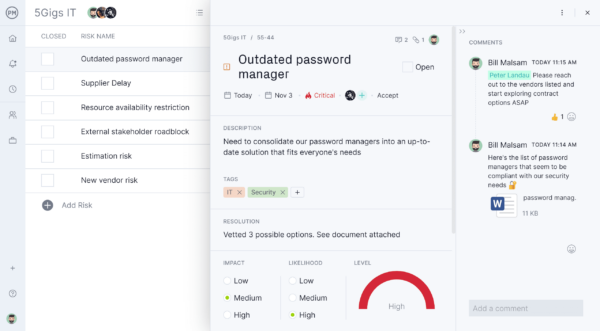
Construction Manager
The construction manager focuses on safety risks and day-to-day operational issues. They enforce safety protocols, monitor work conditions and resolve site problems quickly. Their goal is to prevent accidents, minimize delays and keep crews productive through proactive problem solving and real-time adjustments.
Project Manager
The project manager takes a broader view of risk by monitoring financial, legal and schedule-related threats. They create risk registers, track mitigation plans and escalate issues to stakeholders when necessary. Their approach is preventative, ensuring risks are identified early and contingency plans are in place to avoid major setbacks.
8. Tools and Documents
Tools and documents refer to the systems and paperwork each role uses to manage their work. This includes plans, reports, schedules and software that support decision making and communication throughout the project.
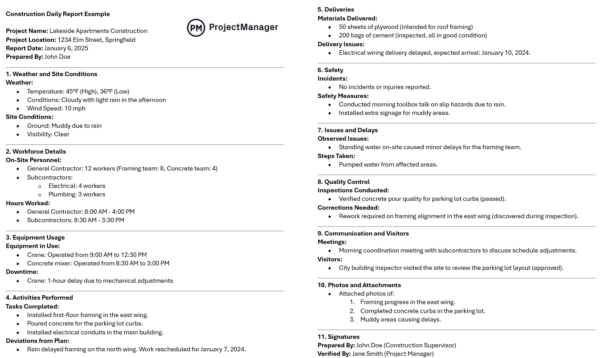
Construction Manager
The construction manager relies on daily logs, safety checklists, site plans and progress reports. They may use construction management software for scheduling and field communication. Their tools help them track productivity, resolve site issues and maintain compliance with safety and quality standards.
Project Manager
The project manager uses Gantt charts, dashboards, risk registers and project documentation. They depend on project management software to monitor performance, manage resources and communicate with stakeholders. Their tools provide a high-level view of progress, enabling them to keep the project aligned with objectives and deadlines.
How ProjectManager Helps Construction Managers and Project Managers
Whether you’re managing daily construction operations or the entire project lifecycle, ProjectManager gives you the tools to stay organized and deliver results. Construction managers can track site progress in real time, assign tasks to crews and document safety checks in one place. Project managers can create schedules, monitor budgets and manage risks with live dashboards and reports. Together, these features keep teams aligned and projects running smoothly from planning to completion.
Learn more about how our software can support both construction managers and project managers.
Stay Organized with Task Lists
ProjectManager allows construction managers and project managers to create and manage detailed task lists for every phase of the project. Construction managers can assign tasks to crews, set priorities and track completion in real time, while project managers can monitor dependencies, deadlines and overall progress. Task lists keep everyone accountable, provide a clear view of work in progress and ensure that nothing falls through the cracks.
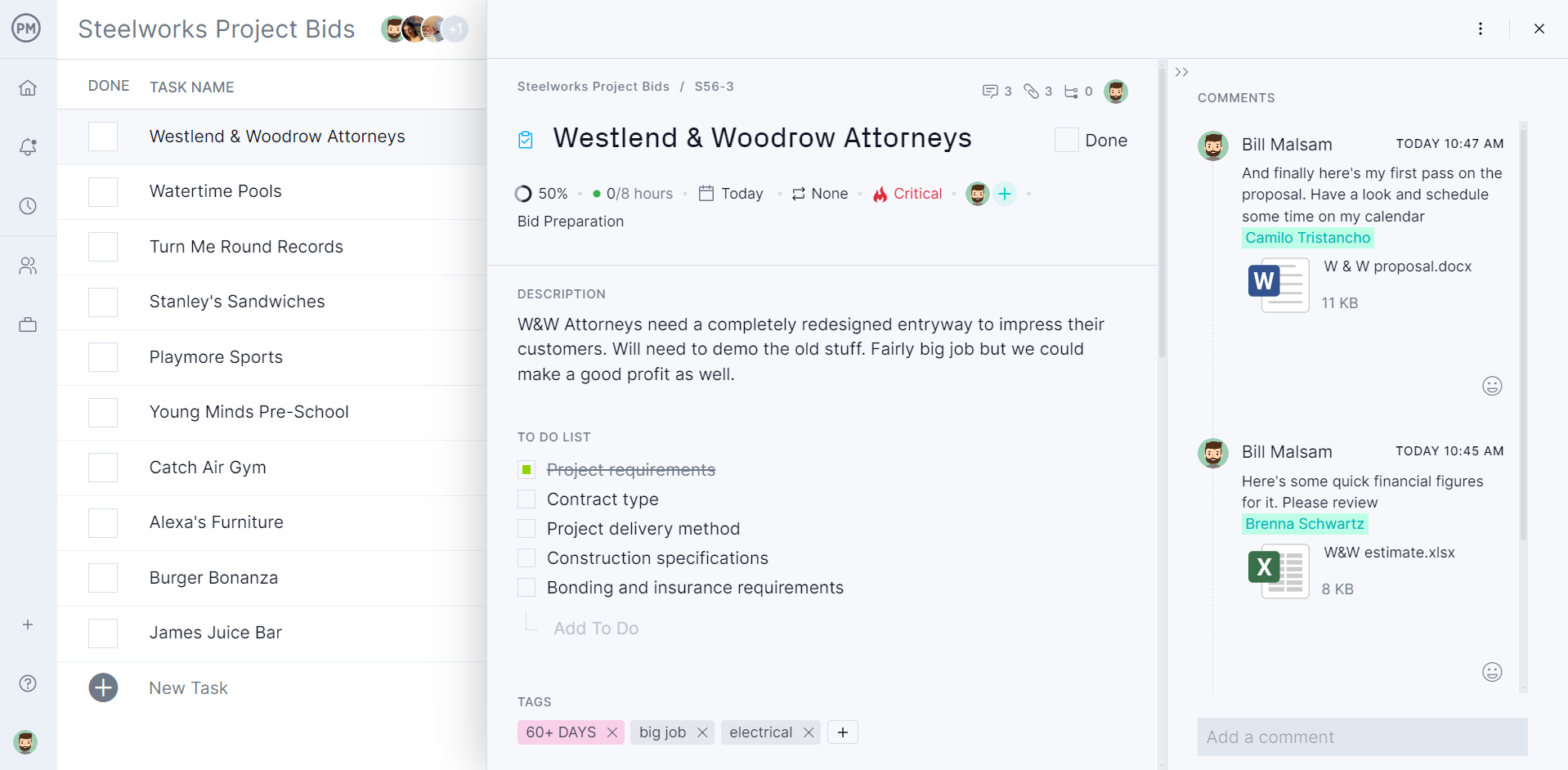
Manage Resources and Track Performance
With built-in resource management, both roles can balance workloads and avoid bottlenecks. Construction managers can see which crews or equipment are available and assign them efficiently. Project managers can track budgets, risks, and deliverables using live dashboards and customizable reports. This real-time visibility allows quick adjustments so projects stay on time and within budget.
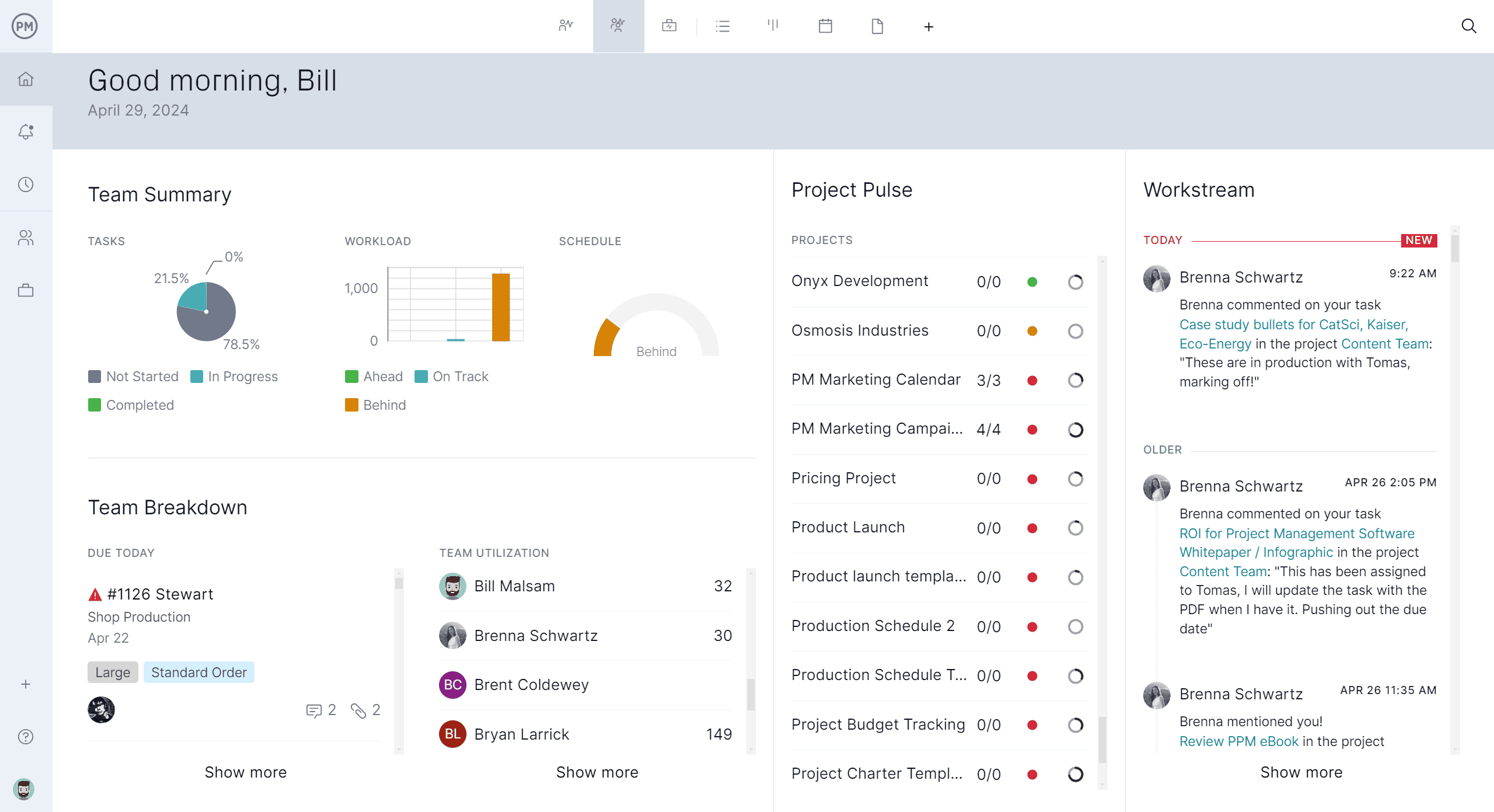
Related Construction Management Content
Looking at a construction manager vs. a project manager helps understand the larger concept of construction management. For those who care to delve into the subject deeper, below are some recent posts on construction methods, techniques, documents and more.
- 18 Construction Methods and Techniques
- 10 Types of Construction Projects with Examples
- 32 Construction Documents (Templates Included)
- 8 Free Construction Forms for Excel and Word
- How to Manage a Construction Project Step by Step
- The Construction Resource Management Process Explained
ProjectManager is online project and portfolio management software that connects teams, whether they’re in the office or at the job site. They can share files, comment at the task level and stay updated with email and in-app notifications. Get started with ProjectManager today for free.


